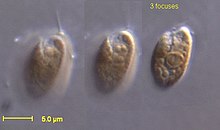
Excavata is a former supergroup of unicellular organisms belonging to the domain Eukaryota. It was first suggested by Simpson and Patterson in 1999 and introduced by Thomas Cavalier-Smith in 2002 as a formal taxon. It contains a variety of free-living and symbiotic forms, and includes some important parasites of humans, such as Giardia and Trichomonas. Excavates were formerly considered to be included in the now obsolete Protista kingdom. They were classified based on their flagellar structures, and were considered to be the most basal flagellate lineage.

Chromista is a proposed but seemingly polyphyletic biological kingdom consisting of single-celled and multicellular eukaryotic species that share similar features in their photosynthetic organelles (plastids). It includes all protists whose plastids contain chlorophyll c, such as some algae, diatoms, oomycetes, and protozoans. It is probably a polyphyletic group whose members independently arose as a separate evolutionary group from the common ancestor of all eukaryotes. As it is assumed the last common ancestor already possessed chloroplasts of red algal origin, the non-photosynthetic forms evolved from ancestors able to perform photosynthesis. Their plastids are surrounded by four membranes, and are believed to have been acquired from some red algae.

Streptophyta, informally the streptophytes, is a clade of plants. The composition of the clade varies considerably between authors, but the definition employed here includes land plants and all green algae except the Chlorophyta and the more basal Prasinodermophyta.

A bikont is any of the eukaryotic organisms classified in the group Bikonta. Many single-celled members of the group, and the presumed ancestor, have two flagella.

The Archaeplastida are a major group of eukaryotes, comprising the photoautotrophic red algae (Rhodophyta), green algae, land plants, and the minor group glaucophytes. It also includes the non-photosynthetic lineage Rhodelphidia, a predatorial (eukaryotrophic) flagellate that is sister to the Rhodophyta, and probably the microscopic picozoans. The Archaeplastida have chloroplasts that are surrounded by two membranes, suggesting that they were acquired directly through a single endosymbiosis event by feeding on a cyanobacterium. All other groups which have chloroplasts, besides the amoeboid genus Paulinella, have chloroplasts surrounded by three or four membranes, suggesting they were acquired secondarily from red or green algae. Unlike red and green algae, glaucophytes have never been involved in secondary endosymbiosis events.

Discosea is a class of Amoebozoa, consisting of naked amoebae with a flattened, discoid body shape. Members of the group do not produce tubular or subcylindrical pseudopodia, like amoebae of the class Tubulinea. When a discosean is in motion, a transparent layer called hyaloplasm forms at the leading edge of the cell. In some discoseans, short "subpseudopodia" may be extended from this hyaloplasm, but the granular contents of the cell do not flow into these, as in true pseudopodia. Discosean amoebae lack hard shells, but some, like Cochliopodium and Korotnevella secrete intricate organic scales which may cover the upper (dorsal) surface of the cell. No species have flagella or flagellated stages of life.

Telonemia is a phylum of microscopic eukaryote, single-celled organisms. They were formerly classified as protists until that kingdom fell out of general use, and are suggested to have evolutionary significance in being a possible transitional form between ecologically important heterotrophic and photosynthetic species among chromalveolates.

Corticata, in the classification of eukaryotes, is a clade suggested by Thomas Cavalier-Smith to encompass the eukaryote supergroups of the following two groups:

The cryptomonads-haptophytes assemblage is a proposed but disputed monophyletic grouping of unicellular eukaryotes that are not included in the SAR supergroup. Several alternative names have been used for the group, including Hacrobia ; CCTH ; and "Eukaryomonadae".

Diaphoretickes is a major group of eukaryotic organisms, with over 400,000 species. The majority of the earth's biomass that carries out photosynthesis belongs to Diaphoretickes.

Picozoa, Picobiliphyta, Picobiliphytes, or Biliphytes are protists of a phylum of marine unicellular heterotrophic eukaryotes with a size of less than about 3 micrometers. They were formerly treated as eukaryotic algae and the smallest member of photosynthetic picoplankton before it was discovered they do not perform photosynthesis. The first species identified therein is Picomonas judraskeda. They probably belong in the Archaeplastida as sister of the Rhodophyta.
Rigifilida is a clade of non-ciliate phagotrophic eukaryotes. It consists of two genera: Micronuclearia and Rigifila.

Haptista is a proposed group of protists made up of centrohelids and haptophytes. Phylogenomic studies indicate that Haptista, together with Ancoracysta twista, forms a sister clade to the SAR+Telonemia supergroup, but it may also be sister to the Cryptista (+Archaeplastida). It is thus one of the earliest diverging Diaphoretickes.
Endohelea is a proposed clade of eukaryotes that are related to Archaeplastida and the SAR supergroup. They used to be considered heliozoans, but phylogenetically they belong to a group of microorganisms known as Cryptista.
Palpitea is a proposed clade of eukaryotes that are related to Archaeplastida and the SAR supergroup.
Corbihelia is a proposed phylum of eukaryotes.

Corbistoma is a proposed clade within the Cryptista which includes the Picobiliphytes and Telonemidae.
The cortical alveoli are cellular organelles composed of vesicles located under the cytoplasmic membrane, to which they give support. They have been defined as membrane sacs that strengthen the cellular cortex through the firm fixation to the underlying membrane and microtubules. They typically form a continuous layer that acts as a flexible film, although they can also constitute a semi-rigid structure or the scales of a theca.
Eolouka is a paraphyletic phylum of protists localized in the clade Discoba. It contains two lineages: Jakobea and Tsukubea, the last containing only one genus, Tsukubamonas.

Gefionella is a genus of excavate protists belonging to the family Malawimonadidae, a basal group in the evolution of eukaryotes. It is a monotypic genus, with only the species Gefionella okellyi, described in 2018. The genus is named after the Norse goddess Gefjon, while the species is named after the scientist Charles J. O'Kelly, a pioneer in the ultrastructural and phylogenetic investigation of excavate flagellates.












